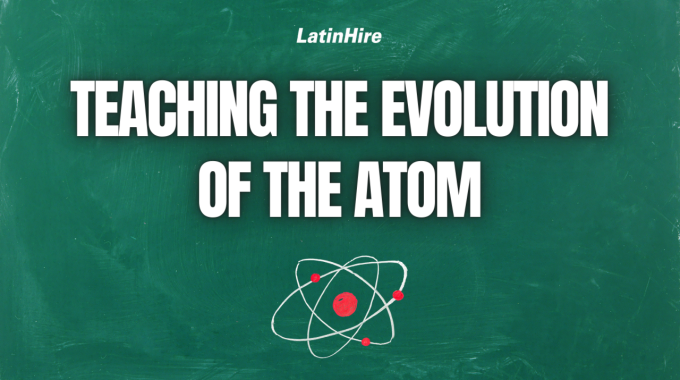In last week’s article, we looked at introducing quantum numbers using a condo analogy as…

Teaching the Evolution of the Atom
The study of the evolution of atomic structure is a fascinating journey through time and discovery. It paints a picture of how our understanding of these tiny building blocks – the atom – has shifted over time.
From ancient ponderings of the philosophers to boggling quantum leaps in recent decades, teaching about the evolution of the atom is an exciting tale of human curiosity and scientific progress that will get your students excited about learning chemistry!
Let’s get started.
1) Ancient Sparks of Atomic Wisdom

The journey of understanding the atom begins with ancient Greek philosophers like Democritus and Leucippus, who first proposed the idea of indivisible particles called “atomos”.
These early thinkers postulated that matter could be broken down into these tiny, unbreakable units. While lacking the technology to provide true evidence of their hypotheses, their ideas laid the groundwork for centuries to come!
2) Dalton’s Chemistry Fiesta
Jumping forward to the early 19th century, John Dalton formulated the first modern atomic theory based on careful experimentation. Dalton’s atomic theory introduced the concept that elements are composed of atoms, which are indivisible and indestructible.
He said that atoms of different elements have specific mass and can combine in certain ratios to form compounds. His work paved the way for the development of the periodic table and helped explain various chemical phenomena.
Here are all the points of Dalton’s atomic theory. (Can you figure out which ones are no longer 100% true today?)
- All matter is made of tiny particles called atoms.
- Atoms are indivisible and indestructible.
- All atoms of a particular element share identical properties, including mass.
- Atoms of different elements contain different mass.
- Atoms of different elements combine in fixed whole-number ratios when forming compounds.
3) Thomson’s Electron Discovery: A Eureka Moment

The late 19th and early 20th centuries marked a period of revolutionary discoveries in the field of atomic structure. J.J. Thomson’s cathode ray experiments led to the discovery of electrons, subatomic particles with a negative charge.
The discovery of these tiny, negatively charged particles in atoms challenged Dalton’s idea of the atom as indivisible, opening the door to a deeper understanding of the complexity of atoms. It appears that atoms aren’t the smallest things to exist!
Thomson’s model of the atom consists of a positively charged mass with embedded negatively charged electrons throughout. This is commonly known as the “plum pudding model” as its description is similar to plum pudding, a popular English dessert.
4) Rutherford’s Gold Rush: A Nuclear Surprise
Ernest Rutherford’s gold foil experiment in 1909 shattered existing atomic models. By shooting positively-charged alpha particles through a thin sheet of gold foil and observing that many alpha particles deflected backwards, Rutherford discovered that atoms possess a dense, positively charged nucleus! This mass of positivity was called a proton.
Rutherford’s nuclear model laid the foundation for our modern understanding of atomic structure and paved the way for the discovery of the neutron.
5) Bohr’s Quantum Groove

Niels Bohr’s quantum model, proposed in 1913, introduced the concept of quantized energy levels within an atom. This model explained the stability of atoms and the emission of specific wavelengths of light during electron transitions.
Bohr’s work contributed to the advancement of quantum mechanics and the understanding of atomic spectra. In this model, the atom has a positive nucleus with negative electrons orbiting around the nucleus at specific energy levels.
6) Quantum Mechanics: The Mind-Boggling Leap
The mid-20th century saw the emergence of quantum mechanics, a revolutionary theory that describes the behavior of particles as both particles and waves (isn’t that trippy) and uncertainty is the name of the game.
Schrodinger’s wave equation and Heisenberg’s uncertainty principle challenged traditional notions of the atom and introduced new ways of understanding particle behavior.
7) Particle Palooza and the Standard Model

As technology progressed, physicists discovered a plethora of subatomic particles beyond protons, neutrons, and electrons. Quarks, gluons, and other exotic particles were unveiled, leading to the development of the Standard Model – a comprehensive theory describing the fundamental particles and forces in the universe.
What do you find the most fascinating about teaching chemistry? Let us know in the comments below!



